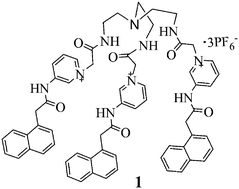Pyridinum-based flexible tripodal cleft: a case of fluorescence sensing of ATP and dihydrogenphosphate under different conditions and cell imaging†
Abstract
Pyridinium-based chemosensor 1 built on tris(aminomethyl)amine (tren) has been designed, synthesized and established as a chemosensor for ATP over ADP, AMP and a series of other anions in aqueous CH3CN at pH 6.5. Compound 1 exhibits a significant change in emission upon complexation of ATP. In CH3CN, the sensor selectively binds H2PO4− and forms an excimer with significant intensity. Furthermore, the intracellular ATP detection using 1 was possible through fluorescent confocal imaging.


 Please wait while we load your content...
Please wait while we load your content...